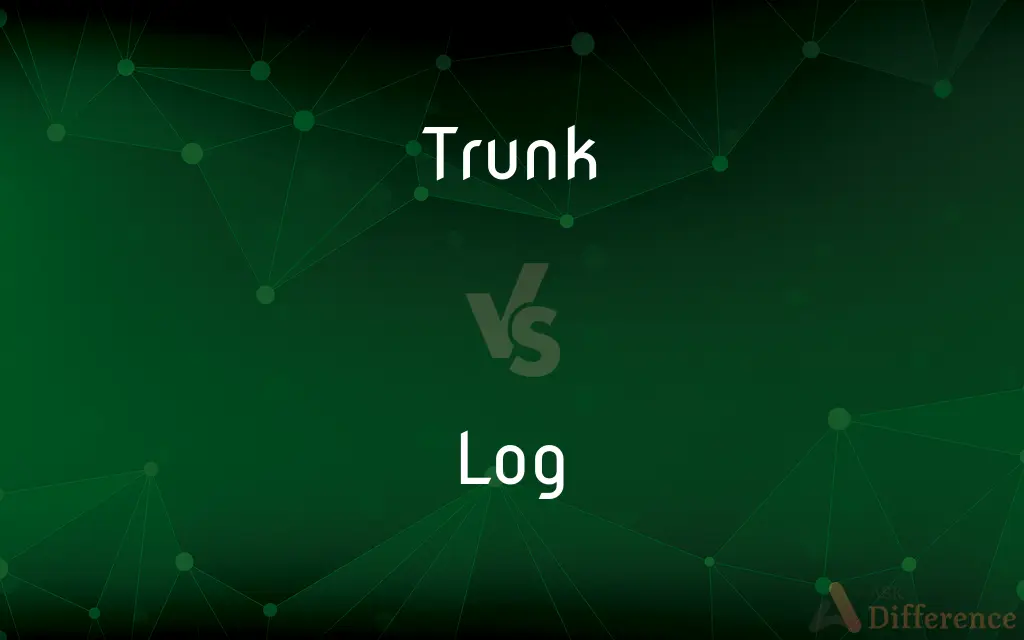Trunk vs. Log — What's the Difference?
By Tayyaba Rehman & Fiza Rafique — Updated on July 30, 2024
A trunk is the main body of a tree, supporting branches and leaves; a log is a cut section of a tree trunk or large branch, often used for timber.

Difference Between Trunk and Log
Table of Contents
ADVERTISEMENT
Key Differences
The trunk of a tree plays a crucial role in supporting the tree's structure, transporting nutrients from the roots to the leaves. On the other hand, a log refers to a section of a tree trunk or a large branch that has been cut down.
Trunk is characterized by its height and girth, which can vary significantly among species. Logs are primarily used for lumber, furniture, and construction materials.
The trunk is essentially the backbone of a tree, providing stability and support for the branches and leaves above ground. The term "log" typically comes into use after a tree has been felled, indicating its transition from a living part of the tree to a raw material.
While trunk facilitating the transport of water and nutrients throughout the tree. Logs can vary in size and length, depending on their intended use, and they undergo processing to be transformed into various wood products.
Comparison Chart
Definition
The main body of a tree
A cut section of a tree trunk or large branch
ADVERTISEMENT
Role in Tree
Supports and transports nutrients
Used as timber or construction material post-cutting
State
Part of a living tree
Cut and removed from the tree
Usage
Provides structure and support
Processed for lumber, furniture, etc.
Appearance
Tall, with bark, extending to branches
Cylindrical, often without branches
Compare with Definitions
Trunk
The central part of a tree that supports the branches and leaves.
The tree's trunk was thick and sturdy, providing a solid foundation.
Log
Used for timber or construction.
The logs were transported to the mill for processing.
Trunk
Varies in thickness among species.
The oak's trunk was much thicker than that of the birch.
Log
Originates from felled trees.
After the storm, many logs lay scattered across the forest floor.
Trunk
Supports the tree's canopy.
The trunk was strong enough to support the heavy branches above.
Log
Processed into wood products.
The log was stripped of its bark before being sawn into planks.
Trunk
Visible above ground.
The tree's trunk twisted artistically as it rose.
Log
A section of the tree trunk or a large branch that has been cut.
The log was cut into smaller pieces for firewood.
Trunk
A person's or animal's body apart from the limbs and head.
Log
Varied in size for different uses.
The carpenter selected a large log for the new project.
Trunk
Main body of a tree, carrying water and nutrients.
The trunk's intricate network transports water from roots to leaves.
Log
A part of the trunk or a large branch of a tree that has fallen or been cut off
A roaring log fire
She tripped over a fallen log
Trunk
The main woody stem of a tree as distinct from its branches and roots.
Log
An official record of events during the voyage of a ship or aircraft
A ship's log
Trunk
The elongated, prehensile nose of an elephant.
Log
An apparatus for determining the speed of a ship, originally one consisting of a float attached to a knotted line that is wound on a reel, the distance run out in a certain time being used as an estimate of the vessel's speed.
Trunk
A large box with a hinged lid for storing or transporting clothes and other articles.
Log
The Ranfurly Shield, an interprovincial rugby union trophy competed for annually in New Zealand
Errors late in the game cost them a shot at the log of wood
Trunk
The main woody axis of a tree.
Log
Short for logarithm
Log x
Log values
Trunk
(Architecture) The shaft of a column.
Log
Enter (an incident or fact) in the log of a ship or aircraft or in another systematic record
The incident has to be logged
Trunk
The body of a human or other vertebrate, excluding the head and limbs.
Log
Cut down (an area of forest) in order to exploit the timber commercially
There are plans to log 250,000 hectares of virgin rainforest
Trunk
The thorax of an insect.
Log
A usually large section of a trunk or limb of a fallen or felled tree.
Trunk
A proboscis, especially the long prehensile proboscis of an elephant.
Log
A long thick section of trimmed, unhewn timber.
Trunk
A main body, apart from tributaries or appendages.
Log
A device trailed from a ship to determine its speed through the water.
Trunk
A trunk line.
Log
A record of a ship's speed, its progress, and any shipboard events of navigational importance.
Trunk
A chute or conduit.
Log
The book in which this record is kept.
Trunk
A watertight shaft connecting two or more decks.
Log
A record of a vehicle's performance, as the flight record of an aircraft.
Trunk
The housing for the centerboard of a vessel.
Log
A record, as of the performance of a machine or the progress of an undertaking
A computer log.
A trip log.
Trunk
A covering over the hatches of a ship.
Log
A logarithm.
Trunk
An expansion chamber on a tanker.
Log
To cut down, trim, and haul the timber of (a piece of land).
Trunk
A cabin on a small boat.
Log
To cut (timber) into unhewn sections.
Trunk
A covered compartment for luggage and storage, generally at the rear of an automobile.
Log
To enter in a record, as of a ship or an aircraft.
Trunk
A large packing case or box that clasps shut, used as luggage or for storage.
Log
To travel (a specified distance, time, or speed)
Logged 30,000 air miles in April.
Trunk
Trunks Shorts worn for swimming or other athletics.
Log
To spend or accumulate (time)
Had logged 25 years with the company.
Trunk
Part of a body.
Log
To cut down, trim, and haul timber.
Trunk
The usually single, more or less upright part of a tree, between the roots and the branches.
Log
The trunk of a dead tree, cleared of branches.
They walked across the stream on a fallen log.
Trunk
The torso.
Log
Any bulky piece as cut from the above, used as timber, fuel etc.
Trunk
The conspicuously extended, mobile, nose-like organ of an animal such as a sengi, a tapir or especially an elephant. The trunks of various kinds of animals might be adapted to probing and sniffing, as in the sengis, or be partly prehensile, as in the tapir, or be a versatile prehensile organ for manipulation, feeding, drinking and fighting as in the elephant.
Log
Anything shaped like a log; a cylinder.
Trunk
(heading) A container.
Log
(nautical) A floating device, usually of wood, used in navigation to estimate the speed of a vessel through water.
Trunk
A large suitcase, chest, or similar receptacle for carrying or storing personal possessions, usually with a hinged, often domed lid, and handles at each end, so that generally it takes two persons to carry a full trunk.
Log
(figuratively) A blockhead; a very stupid person.
Trunk
A box or chest usually covered with leather, metal, or cloth, or sometimes made of leather, hide, or metal, for holding or transporting clothes or other goods.
Log
A heavy longboard.
Trunk
The luggage storage compartment of a sedan/saloon-style car.
Log
(figuratively) A rolled cake with filling.
Trunk
(automotive) A storage compartment fitted behind the seat of a motorcycle.
Log
(mining) A weight or block near the free end of a hoisting rope to prevent it from being drawn through the sheave.
Trunk
(heading) A channel for flow of some kind.
Log
(vulgar) A piece of feces.
Trunk
A circuit between telephone switchboards or other switching equipment.
Log
(vulgar) A penis.
Trunk
A chute or conduit, or a watertight shaft connecting two or more decks.
Log
A logbook, or journal of a vessel's (or aircraft's) progress.
Trunk
A long, large box, pipe, or conductor, made of plank or metal plates, for various uses, as for conveying air to a mine or to a furnace, water to a mill, grain to an elevator, etc.
Log
A chronological record of actions, performances, computer/network usage, etc.
Trunk
(archaic) A long tube through which pellets of clay, peas, etc., are driven by the force of the breath. A peashooter
Log
(computer science) Specifically, an append-only sequence of records written to file.
Trunk
(mining) A flume or sluice in which ores are separated from the slimes in which they are contained.
Log
A Hebrew unit of liquid volume (about 3{{nbsp}}liter).
Trunk
(software engineering) In software projects under source control: the most current source tree, from which the latest unstable builds (so-called "trunk builds") are compiled.
Log
Synonym of logarithm. Category:en:Functions
To multiply two numbers, add their logs.
Trunk
The main line or body of anything.
The trunk of a vein or of an artery, as distinct from the branches
Log
(sciences) A difference of one in the logarithm, usually in base 10; an order of magnitude.
Trunk
(transport) A main line in a river, canal, railroad, or highway system.
Log
(transitive) To cut trees into logs.
Trunk
(architecture) The part of a pilaster between the base and capital, corresponding to the shaft of a column.
Log
(transitive) To cut down (trees).
Trunk
A large pipe forming the piston rod of a steam engine, of sufficient diameter to allow one end of the connecting rod to be attached to the crank, and the other end to pass within the pipe directly to the piston, thus making the engine more compact.
Log
(intransitive) To cut down trees in an area, harvesting and transporting the logs as wood.
Trunk
(in the plural) swimming trunks
Log
(transitive) To make, to add an entry (or more) in a log or logbook.
To log the miles travelled by a ship
Trunk
To lop off; to curtail; to truncate.
Log
(transitive) To travel (a distance) as shown in a logbook.
Trunk
To extract (ores) from the slimes in which they are contained, by means of a trunk.
Log
(transitive) To travel at a specified speed, as ascertained by a chip log.
Trunk
(telecommunication) To provide simultaneous network access to multiple clients by sharing a set of circuits, carriers, channels, or frequencies.
Log
A Hebrew measure of liquids, containing 2.37 gills.
Trunk
The stem, or body, of a tree, apart from its limbs and roots; the main stem, without the branches; stock; stalk.
About the mossy trunk I wound me soon,For, high from ground, the branches would requireThy utmost reach.
Log
A bulky piece of wood which has not been shaped by hewing or sawing.
Trunk
The body of an animal, apart from the head and limbs.
Log
An apparatus for measuring the rate of a ship's motion through the water.
Trunk
The main body of anything; as, the trunk of a vein or of an artery, as distinct from the branches.
Log
The record of the rate of speed of a ship or airplane, and of the course of its progress for the duration of a voyage; also, the full nautical record of a ship's cruise or voyage; a log slate; a log book.
Trunk
That part of a pilaster which is between the base and the capital, corresponding to the shaft of a column.
Log
A record and tabulated statement of the person(s) operating, operations performed, resources consumed, and the work done by any machine, device, or system.
Trunk
That segment of the body of an insect which is between the head and abdomen, and bears the wings and legs; the thorax; the truncus.
Log
A weight or block near the free end of a hoisting rope to prevent it from being drawn through the sheave.
Trunk
The proboscis of an elephant.
Log
A record of activities performed within a program, or changes in a database or file on a computer, and typically kept as a file in the computer.
Trunk
A long tube through which pellets of clay, p as, etc., are driven by the force of the breath.
He shot sugarplums them out of a trunk.
Log
To enter in a ship's log book; as, to log the miles run.
Trunk
A box or chest usually covered with leather, metal, or cloth, or sometimes made of leather, hide, or metal, for containing clothes or other goods; especially, one used to convey the effects of a traveler.
Locked up in chests and trunks.
Log
To record any event in a logbook, especially an event relating to the operation of a machine or device.
Trunk
A flume or sluice in which ores are separated from the slimes in which they are contained.
Log
To engage in the business of cutting or transporting logs for timber; to get out logs.
Trunk
A large pipe forming the piston rod of a steam engine, of sufficient diameter to allow one end of the connecting rod to be attached to the crank, and the other end to pass within the pipe directly to the piston, thus making the engine more compact.
Log
To move to and fro; to rock.
Trunk
A long, large box, pipe, or conductor, made of plank or metal plates, for various uses, as for conveying air to a mine or to a furnace, water to a mill, grain to an elevator, etc.
Log
A segment of the trunk of a tree when stripped of branches
Trunk
To lop off; to curtail; to truncate; to maim.
Log
Large log at the back of a hearth fire
Trunk
The main stem of a tree; usually covered with bark; the bole is usually the part that is commercially useful for lumber
Log
The exponent required to produce a given number
Trunk
Luggage consisting of a large strong case used when traveling or for storage
Log
A written record of messages sent or received;
They kept a log of all transmission by the radio station
An email log
Trunk
The body excluding the head and neck and limbs;
They moved their arms and legs and bodies
Log
A written record of events on a voyage (of a ship or plane)
Trunk
Compartment in an automobile that carries luggage or shopping or tools;
He put his golf bag in the trunk
Log
Measuring instrument that consists of a float that trails from a ship by a knotted line in order to measure the ship's speed through the water
Trunk
A long flexible snout as of an elephant
Log
Enter into a log, as on ships and planes
Log
Cut lumber, as in woods and forests
Common Curiosities
What happens to the trunk when a tree is cut down?
When a tree is cut down, its trunk can be processed into logs for various uses.
What is the main difference between a trunk and a log?
The trunk is the main body of a living tree, while a log is a cut section of a trunk or large branch, primarily used as timber.
Are all logs made from tree trunks?
Most logs are made from tree trunks, but they can also come from large branches.
Do trunks have a uniform thickness?
No, trunk thickness varies widely among tree species and individual trees.
Is the term 'log' used before a tree is cut?
No, the term 'log' is typically used after the tree has been cut down.
What role does the trunk play in the ecosystem?
The trunk provides habitat and food for various species, contributing to the ecosystem's biodiversity.
Can a trunk exist without branches?
Yes, a trunk can exist without branches, especially in young or specially pruned trees.
How are logs prepared for use in furniture making?
Logs intended for furniture are often dried and milled into boards or planks, ensuring they are suitable for fine woodworking.
Are trunks always straight?
No, some trees have trunks that twist or bend due to genetic factors or environmental conditions.
Why are logs important in construction?
Logs are a durable and versatile material used in construction for their strength and aesthetic appeal.
Can logs be used for purposes other than lumber?
Yes, logs can also be used for making furniture, in landscaping, and as fuel for fires.
How does the trunk contribute to a tree's health?
The trunk transports water and nutrients between the roots and leaves, essential for the tree's growth and health.
Can the trunk of a tree regenerate after being cut?
Some tree species can sprout new growth from the stump, but the original trunk does not regenerate.
How does the diameter of a trunk affect its use as a log?
The diameter of the trunk can determine the log's suitability for different purposes, with larger diameters preferred for certain construction projects.
What determines the size of a log?
The size of a log is determined by the size of the tree from which it was cut and the requirements of its intended use.
Share Your Discovery

Previous Comparison
Misconstrue vs. Construe
Next Comparison
Demo vs. SampleAuthor Spotlight
Written by
Tayyaba RehmanTayyaba Rehman is a distinguished writer, currently serving as a primary contributor to askdifference.com. As a researcher in semantics and etymology, Tayyaba's passion for the complexity of languages and their distinctions has found a perfect home on the platform. Tayyaba delves into the intricacies of language, distinguishing between commonly confused words and phrases, thereby providing clarity for readers worldwide.
Co-written by
Fiza RafiqueFiza Rafique is a skilled content writer at AskDifference.com, where she meticulously refines and enhances written pieces. Drawing from her vast editorial expertise, Fiza ensures clarity, accuracy, and precision in every article. Passionate about language, she continually seeks to elevate the quality of content for readers worldwide.













































